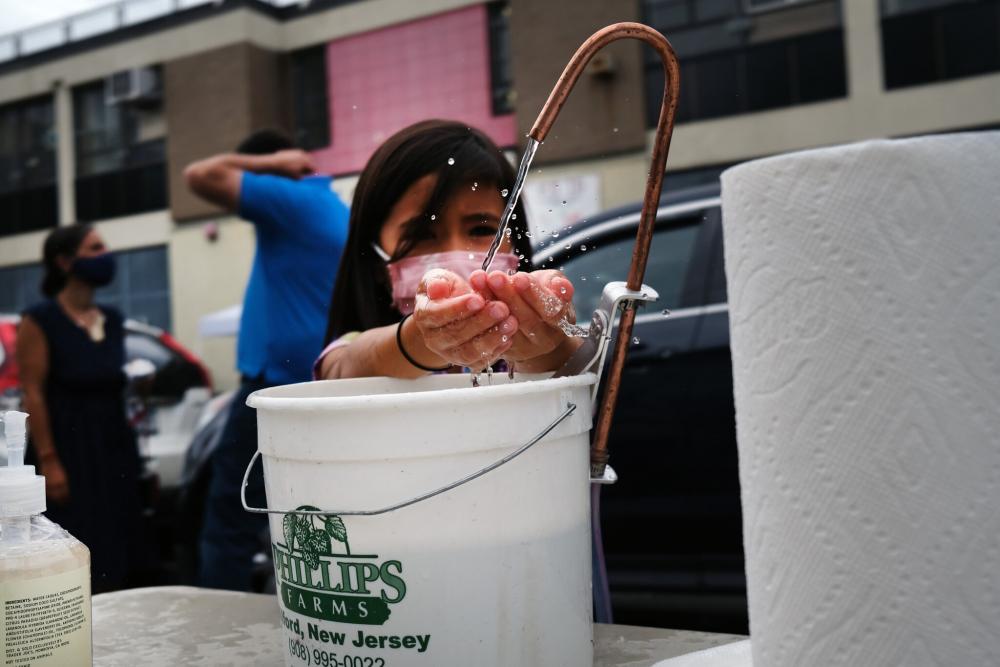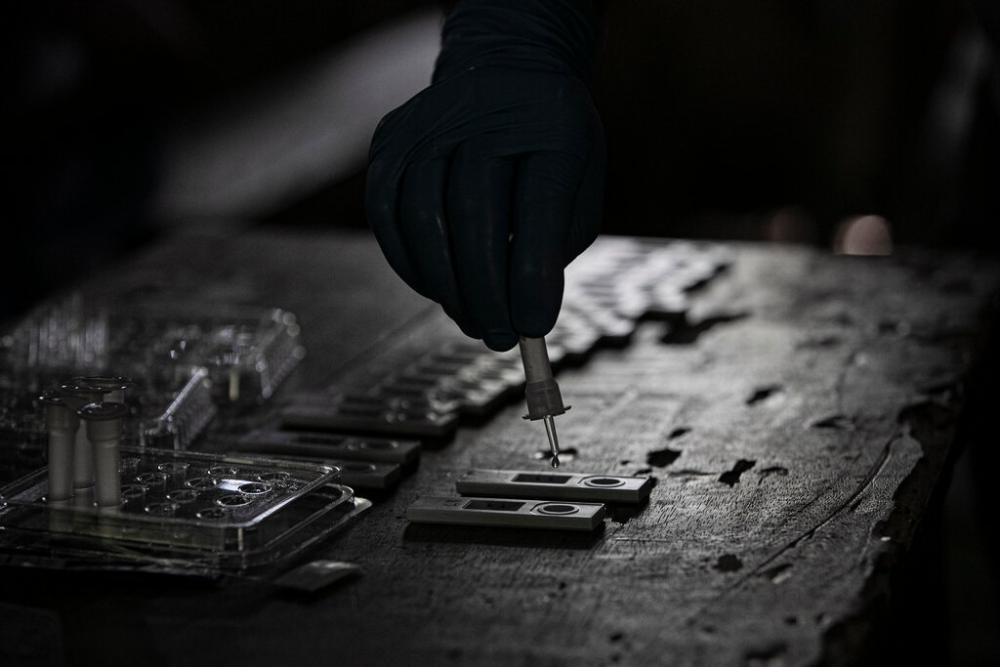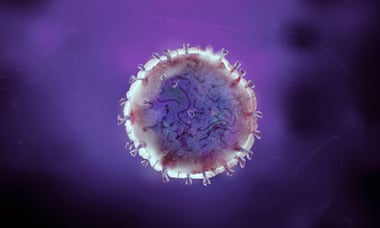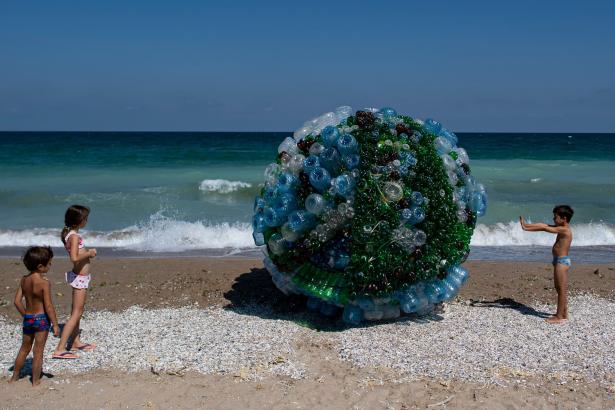How Do Children Fight Off the Coronavirus?
Apoorva Mandavilli
New York Times
September 25, 2020
https://www.nytimes.com/2020/09/25/health/coronavirus-children-immune.html
Why the coronavirus affects children much less severely than adults has become an enduring mystery of the pandemic. The vast majority of children do not get sick; when they do, they usually recover.
The first study to compare the immune response in children with that in adults suggests a reason for children’s relative good fortune. In children, a branch of the immune system that evolved to protect against unfamiliar pathogens rapidly destroys the coronavirus before it wreaks damage on their bodies, according to the research, published this week in Science Translational Medicine.
“The bottom line is, yes, children do respond differently immunologically to this virus, and it seems to be protecting the kids,” said Dr. Betsy Herold, a pediatric infectious disease expert at Albert Einstein College of Medicine who led the study.
In adults, the immune response is much more muted, she and her colleagues found.
When the body encounters an unfamiliar pathogen, it responds within hours with a flurry of immune activity, called an innate immune response. The body’s defenders are quickly recruited to the fight and begin releasing signals calling for backup.
Children more often encounter pathogens that are new to their immune systems. Their innate defense is fast and overwhelming.
Over time, as the immune system encounters pathogen after pathogen, it builds up a repertoire of known villains. By the time the body reaches adulthood, it relies on a more sophisticated and specialized system adapted to remembering and fighting specific threats.
If the innate immune system resembles emergency responders first on the scene, the adaptive system represents the skilled specialists at the hospital.
The adaptive system makes sense biologically because adults rarely encounter a virus for the first time, said Dr. Michael Mina, a pediatric immunologist at the Harvard T.H. Chan School of Epidemiology in Boston.
But the coronavirus is new to everyone, and the innate system fades as adults grow older, leaving them more vulnerable. In the time it takes for an adult body to get the specialized adaptive system up and running, the virus has had time to do harm, Dr. Herold’s research suggests.

Because children more often encounter viruses for the first time, their bodies respond with an “innate” immune reaction that may effectively fight off the coronavirus. Credit...Spencer Platt/Getty Images
She and her colleagues compared immune responses in 60 adults and 65 children and young adults under the age of 24, all of whom were hospitalized at the Montefiore Medical Center in New York City from March 13 to May 17.
The patients included 20 children with multisystem inflammatory syndrome, the severe and sometimes deadly immune overreaction linked to the coronavirus.
Over all, the children were only mildly affected by the virus, compared with adults, mostly reporting gastrointestinal symptoms like diarrhea and a loss of taste or smell. Only five children needed mechanical ventilation, compared with 22 of the adults; two children died, compared with 17 adults.
Children had much higher blood levels of two particular immune molecules, interleukin 17A and interferon gamma, the researchers found. The molecules were most abundant in the youngest patients and decreased progressively with age.
“We think that is protecting these younger children, particularly from severe respiratory disease, because that’s really the major difference between the adults and the kids,” Dr. Herold said.
In some adult Covid-19 patients, she added, the lack of a strong early response also may be setting off an intense and unregulated adaptive reaction that may lead to acute respiratory distress syndrome and death.
All viruses have tricks to evade the innate immune system, and the coronavirus is particularly adept. Produced early in the course of infection, interleukin 17A may help children thwart the virus’s attempts to evade the innate response and to ward off the later adaptive response.
“We think that also protects them from sort of making the more vigorous adaptive immune response that’s associated with that hyper-inflammation,” Dr. Herold said.
Other experts said the study was well done but suffered — as most studies of the coronavirus do — from enrolling patients too late in the infection.
The innate immune response is set off hours after exposure to a pathogen, but people generally don’t come to the hospital until about a week after infection with the coronavirus, when symptoms are severe, said Akiko Iwasaki, an immunologist at Yale University.
That’s too late to study how the innate immune system responds to the virus, she said, adding, “By the time people are sick, it’s way past that time point.”
Still, the new data negate a couple of popular theories about why children are protected from the virus, she said.
Some scientists have suspected that children may fare better because they tend to have had more recent exposure to coronaviruses that cause common colds, which might offer them some protection.
But the new study found no significant differences in the immune responses to those viruses between the groups, Dr. Iwasaki noted.
Another theory held that children generate a stronger antibody response that clears the virus more efficiently than in adults. But the new study found that the sickest older people actually produced the most powerful antibodies.
That result may confirm a nagging worry among researchers: that the presence of those potent antibodies contributes to the illness in adults, instead of helping them fight the virus — a phenomenon called antibody-dependent enhancement. Vaccine manufacturers are carefully monitoring trial subjects for signs of this problem.
“That’s a theme that everybody’s been dancing around,” said Dr. Jane C. Burns, a pediatric infectious disease expert at University of California, San Diego. “Is it possible that high titers of some antibodies actually are bad for you, as opposed to good for you?”
Researchers also must learn what happens in children after the initial immune surge, Dr. Burns said. Children produce a strong immune response, but their bodies must turn it off quickly after the danger has passed.
If this virus becomes endemic, like the coronaviruses causing common colds, children eventually will develop adaptive defenses so strong that they will not experience the problems that adults are having now, Dr. Mina said.
“We will eventually age out of this virus.”
*****************************************************************************************
Huge Study of Coronavirus Cases in India Offers Some Surprises to Scientists
Apoorva Mandavilli
New York Times
September 30, 2020 Updated October 4, 2020
https://www.nytimes.com/2020/09/30/health/covid-india-children.html
With 1.3 billion people jostling for space, India has always been a hospitable environment for infectious diseases of every kind. And the coronavirus has proved to be no exception: The country now has more than six million cases, second only to the United States.
An ambitious study of nearly 85,000 of those cases and nearly 600,000 of their contacts, published Wednesday in the journal Science, offers important insights not just for India, but for other low- and middle-income countries.
Among the surprises: The median hospital stay before death from Covid-19, the illness caused by the coronavirus, was five days in India, compared with two weeks in the United States, possibly because of limited access to quality care. And the trend in increasing deaths with age seemed to drop off after age 65 — perhaps because Indians who live past that age tend to be relatively wealthy and have access to good health care.
The contact tracing study also found that children of all ages can become infected with the coronavirus and spread it to others — offering compelling evidence on one of the most divisive questions about the virus.
And the report confirmed, as other studies have, that a small number of people are responsible for seeding a vast majority of new infections.
An overwhelming majority of coronavirus cases globally have occurred in resource-poor countries, noted Joseph Lewnard, an epidemiologist at the University of California, Berkeley, who led the study. But most of the data has come from high-income countries.
“It still surprises me that it took until this point for a lot of data to come out of a low- or middle-income country about the epidemiology of Covid,” he said.
In particular, he added, few studies anywhere have done contact tracing at the scale of the study.
“I think it’s some of the most important data we collect in an epidemic in order to decide what kinds of interactions are safe, and what kinds are not,” he said. And yet, “data like this has not really been published very much.”
Though its overall total of cases is huge, the per capita number of cases reported daily in India — and in many other low-income countries, including in Africa — is lower than in Spain, France or even the United States. And its number of deaths has not yet topped 100,000 — which has surprised some scientists.
“It still surprises me that it took until this point for a lot of data to come out of a low- or middle-income country about the epidemiology of Covid,” he said.
In particular, he added, few studies anywhere have done contact tracing at the scale of the study.
“I think it’s some of the most important data we collect in an epidemic in order to decide what kinds of interactions are safe, and what kinds are not,” he said. And yet, “data like this has not really been published very much.”
Though its overall total of cases is huge, the per capita number of cases reported daily in India — and in many other low-income countries, including in Africa — is lower than in Spain, France or even the United States. And its number of deaths has not yet topped 100,000 — which has surprised some scientists.
India recorded its first case of Covid-19 on Jan. 30 in an Indian citizen evacuated from China. The government began screening travelers from China and other countries on Feb. 7 and extended these efforts to travelers by sea and land on March 15. The country shut down on March 25 but reopened two months later, despite soaring rates of infection.
The study focused on two southern Indian states, Andhra Pradesh and Tamil Nadu, which together have a population of about 128 million, and represent two of the five Indian states with the most cases. They also have among the most sophisticated health care systems in the country.
Contact tracers reached more than three million contacts of the 435,539 cases in these two states, although this still did not represent the full set of contacts. The researchers analyzed data for the 575,071 contacts for whom test information was available.
“I think what they were able to do is actually really remarkable, to be quite honest,” said Dr. Kuppalli, who has spent time in Tamil Nadu doing public health work. Contact tracing has proved difficult enough to do in the United States, she said. “I can’t imagine what it would be in a place like India, where it’s such a more crowded, crowded area.”
The contact tracing data revealed that the people infected first — known as index cases — were more likely to be male and older than their contacts. That may be because men are more likely to be out in situations where they might be infected, more likely to become symptomatic and get tested if they do become infected, or perhaps more likely to respond to contact tracers’ calls for information, Dr. Lewnard said.

A health worker performed a coronavirus test at a college near Gauhati, India, on Sept. 30, 2020. India’s six million cases is second only to the United States.Credit...Anupam Nath/Associated Press
He and his colleagues also looked at infections in contacts by age and sex, and found that infected people tend to spread the virus to those of similar ages.
That’s not surprising because people generally tend to mix with their own age groups, Jeffrey Shaman, an epidemiologist at Columbia University in New York, said: “That’s a fairly robust result.”
For example, more than 5,300 school-aged children in the study had infected 2,508 contacts but were more likely to spread the virus to other children of a similar age. Because the researchers were not able to get information for all of the contacts, they could not assess the children’s ability to transmit relative to adults. But the finding has relevance in the school debate, as some people have argued that children spread the virus to a negligible degree, if at all.
“The claims that children have no role in the infection process are certainly not correct,” Dr. Lewnard said. “There’s, granted, not an enormous number of kids in the contact tracing data, but those who are in it are certainly transmitting.”
Over all, the researchers found, 71 percent of the people in the study did not seem to have transmitted the virus to anyone else; instead, just 5 percent of people accounted for 80 percent of the infections detected by contact tracing.
This is different from the idea of “super spreader” events in which a single person infected hundreds of people at a crowded gathering, Dr. Lewnard said.
The researchers noticed a key difference in those who did become sick and were hospitalized: They died on average within five days of being hospitalized, compared with two to eight weeks in other countries. The patients in India may deteriorate faster because of other underlying conditions like diabetes and high blood pressure or poor overall health, Dr. Lewnard said.
Access to health care may also play a role, said Dr. Ashish Jha, dean of the School of Public Health at Brown University, who has advised the Indian government on its health care infrastructure before the pandemic.
Although India has some excellent hospitals, most hospitals in the country are ill-equipped, have few beds and fewer doctors, Dr. Jha said. Most people in India also do not have health insurance that would allow them care from private hospitals.
“There are going to be these large financial barriers that make people wait until they get very, very sick,” Dr. Jha said.
Conditions may be similarly dire in other resource-poor nations. The amount of time patients may spend in the hospital is a “key planning parameter” for governments preparing for outbreaks, Dr. Lewnard said, and longer hospital stays can create bottlenecks during a surge.
Among those infected, the researchers found an overall case-fatality rate of 2 percent. The rate rose sharply with age, as it did elsewhere. But unlike in other countries, after age 65, the deaths sloped downward again.
“It leads to a younger death distribution over all in the population than you would project,” Dr. Lewnard said. The difference was not fully accounted for by the distribution of ages in the population.
At 69 years, the life expectancy in India is 10 years lower than in the United States. The Indians who survive into old age may be more likely to survive the disease because of better health and access to health care, he and others said.
A majority of Indians have a hardscrabble existence, earning a living as farmers, factory workers or day laborers, Dr. Jha said.
“Those jobs are physically very, very demanding, and they have high fatality rates,” he added. “They are just much less likely to make it into their late 70s or 80s compared to people who are white-collar workers.”
Dr. Jha said he appreciated the study over all, but cautioned against extrapolating its findings too far. He is from the state of Bihar, among the most rural and poor states in India, whereas Andhra Pradesh and Tamil Nadu, the two states in the study, are among the best equipped to deal with an outbreak, he said.
“It is really important to understand this is not the experience of Bihar, this is not the experience of D.R.C.,” he said, referring to the Democratic Republic of Congo. “This is a much rosier picture than what you are likely to see in those places.”
But other experts were impressed with the scale and scope of the study. “India has been the nexus of the most cases recorded for the last three, four weeks,” Dr. Shaman said.
“To see it in the Indian milieu is very important,” he said. “We can’t just study it in a few countries and then walk away.”
****************************************************************************
Scientists Study Whether Immune Response Wards off or Worsens Covid
Robin McKie
The Guardian
October 4, 2020
https://www.theguardian.com/science/2020/oct/04/scientists-study-whether-immune-response-wards-off-or-worsens-covid
British scientists have launched a major study aimed at uncovering the critical role that human antibodies and other immune defences play in the severity of Covid-19 cases.
Results could support some scientists’ belief that antibodies triggered by common colds could be protecting children against the disease. Alternatively, the study could confirm other researchers’ fears that some immune responses to the virus may trigger deadly inflammatory reactions that could bedevil attempts to create anti-Covid vaccines.
“This study could go in two very different directions,” said Michael Levin, professor of paediatrics at Imperial College London. “It could reveal that cross-reacting antibodies explain why children are less likely to suffer from severe Covid-19, or it might show patients’ own immune responses cause life-threatening effects.”
The study is being carried out by Levin’s group, a team led by Professor George Kassiotis at London’s Francis Crick Institute, and scientists led by Dan Davis, University College London. They will use thousands of samples which have been collected as part of existing studies funded by the EU and Wellcome.
Much of the groups’ work will focus on antibodies, key immune defence proteins that bind on to viruses to block their activity. When Covid-19 first appeared, scientists began searching for antibodies against the virus in patients and healthy individuals and to their surprise found them not just in samples taken from recently infected people but in specimens that had been collected before the pandemic began.
“We discovered a small group – about 6% of the UK population – already had antibodies that could recognise the new virus, although they’ve never been exposed to it,” said Kassiotis. “We realised there must be cross reactivity occurring between common cold coronaviruses and the new pandemic strain. Both are coronaviruses, after all.”

Coronaviruses cause about a fifth of UK common colds and antibodies triggered by them latch on to the Covid-19 virus. Photograph: Media Point Inc/Alamy
Coronaviruses cause about a fifth of UK common colds and antibodies triggered by them latch on to the Covid-19 virus. But could they actually be blocking Covid activity? “Our laboratory experiments suggest this may be the case,” Kassiotis said. “These antibodies may actually protect against Covid-19.”
Adults get common colds caused by coronaviruses once every two or three years. In contrast children get them five or six times a year because they constantly reinfect each other at school, said Kassiotis. As a result about 60% of them have coronavirus antibodies, 10 times the adult level.
“Children do not generally get severe Covid-19 and I believe that protection is provided by cross-reacting antibodies triggered by repeating coronavirus colds,” said Kassiotis.
Crucially, it appears coronavirus antibody levels drop steeply when children leave school and that raises a worry: UK children may have lost immunity during the lockdown. “The next coronavirus to spread among them could be the pandemic strain, not the seasonal cold variety,” said Kassiotis. “That does not seem to be happening but it is a concern.”
The new Crick-Imperial-UCL study will analyse samples from thousands of people to see if they possess antibodies against Covid and also determine if they display any other immune reactions that might have been triggered by coronaviruses, including responses in T-cells. It will also study how individuals fare as the pandemic progresses to see how well antibodies protect them.
Kassiotis said many different types of antibodies are generated by the body’s immune system when the disease strikes. Some are specific to Covid-19. Others lock on to sections shared by all coronaviruses – and by focusing on those sections, it might be possible to design a vaccine to protect against all coronaviruses. “We would then be better prepared for the next pandemic.”
But there are other aspects of the body’s immune response to Covid-19 that could have a very different impact. “After the pandemic began we started seeing severely ill, infected children with intense inflammation and multi-organ failure,” said Levin. “We were puzzled because their illness was occurring not at the height of their infection but several weeks afterwards – when the virus had gone but antibodies were high. We feared those antibodies might actually be causing the damage.”
The culprit could be a phenomenon called antibody dependent enhancement of disease, Levin added. “The Dengue fever virus provides a good example. There are three strains of it. If you get infected with one strain that might not make you terribly ill.
“But if you later get infected with a second, different strain, you could be in trouble. The antibodies your immune system first made can actually make the disease worse when you encounter a slightly different strain of the virus.”
This drawback has plagued attempts to develop a vaccine for dengue fever. Triggering antibody production – as vaccines attempt to do – can enhance the disease’s impact, unless those antibodies are effective against all three dengue strains.
Levin said he was concerned that the newly recognised childhood inflammatory disease associated with Covid-19 could be due to antibodies that later cause inflammation and damage to organs. If so, coronavirus antibodies induced by a vaccine might cause a similar problem.
“We need to understand whether antibodies which children develop against the common cold coronaviruses and Covid-19 protect against severe disease, or alternatively whether some children and adults make antibodies that might make the disease worse. Hopefully, our study will give us answers and provide the essential information we need to develop safe vaccines.”
Apoorva Mandavilli is a reporter for The Times, focusing on science and global health. She is the 2019 winner of the Victor Cohn Prize for Excellence in Medical Science Reporting. @apoorva_nyc
Robin McKie is science and environment editor for the Observer


Spread the word